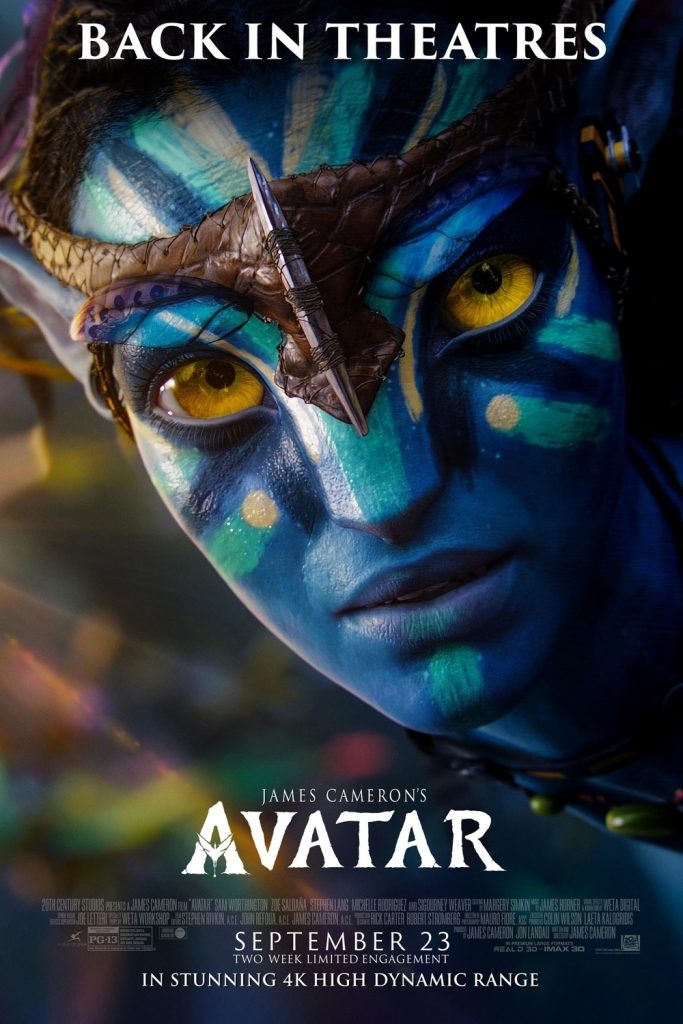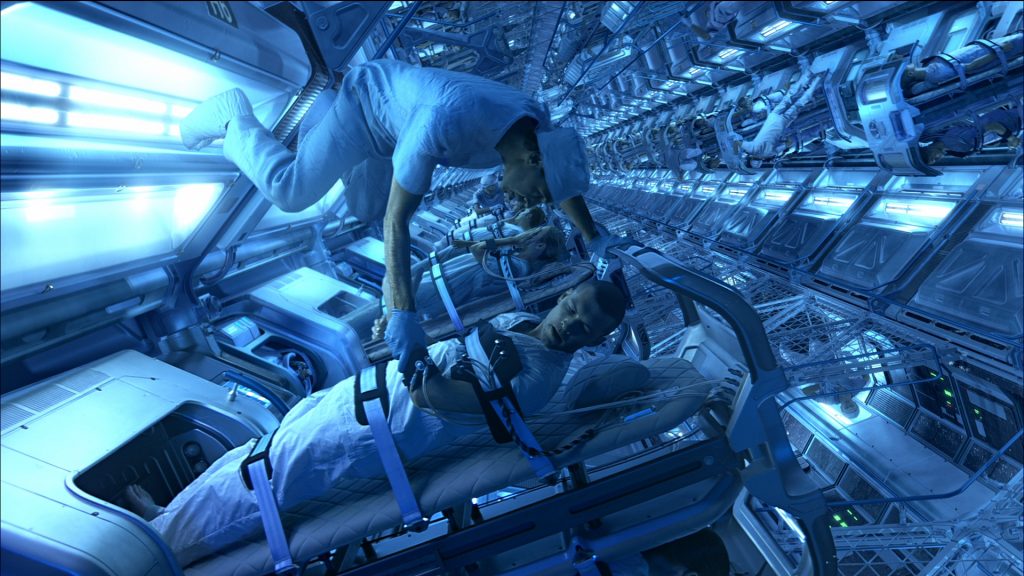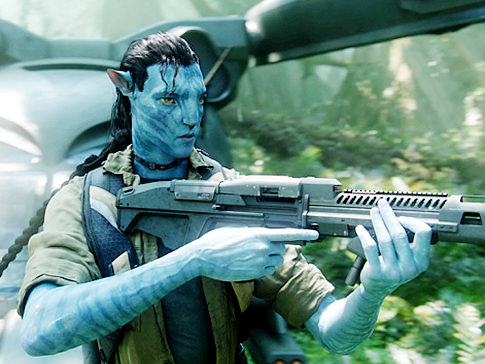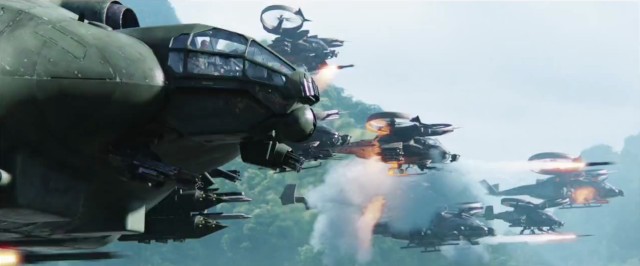
Avatar Is a Stunning Stereo3D Work of Art—Here is Why.
Aside from a spiffy special presentation poster at the door of the feature, what is my takeaway from the IMAX 3D presentation of AVATAR? My history with stereo3D filmmaking informs me a lot about the process, and I’ll go into a little of that. It had a large impact in the movie industry for several reasons — most of them the evolution of visual effects, stereo3D conversion, and the rise and fall of the 3D television industry — and I can speak to a few of these subjects with some knowledge, as stereo3D visual Effects and conversion are my profession as well.
Here is the short answer: See it in IMAX3D!!
The Glory of Avatar in Stereo3D
Avatar in 2009 was the first of modern 3D movies to grab public attention. Recent developments in digital cinema made that possible. Not just the advent of digital cameras that George Lucas helped usher in with the Star Wars prequels, but also the new digital projectors which had the ability to project 3D content without all the problems that haunted it during the early 1980s (See Space Hunter: Adventures in the Forbidden Zone, and JAWS3D) — a lot of this advance was due to the research driven by Lenny Lipton, who originally wrote the poem that became the song Puff the Magic Dragon decades earlier, and was an avid supporter of the medium [Lenny Lipton video interview],
One of the biggest complaints about 3D projection, even at the original release of Avatar is the use of glasses, which reduce the brightness of the overall image. The standard Real-D projector also has a slight problem with images being presented one after the other, since it is a single projector, in which the stereo3D image can have some faux depth created as objects move across the frame — raising from the screen going one direction, and sinking into the screen traveling the other. It seems persistence of vision is independent per-eye, and this slight offset in time causes an issue. However, the IMAX3D experience is much brighter due to using two projectors, and recently adding High Dynamic Range laser projectors to several theaters. The dual projectors also are perfectly in synchronization with each other, so the intended 3D experience is delivered properly (I have since learned that certain laser projector systems are capable of single projector 3D projection, so check your theater, but IMAX seems to have standardized on dual projectors for the most part).
The theater I saw Avatar The IMAX Experience in was an IMAX3D DLP projector, so the additional HDR brightness was not available — but the new color grade (a term used to describe how the filmmaker adjusts colors and contrast, similar to the way you can adjust them on a television, but with a lot more control) was very lush. Linear polarized clip-ons for my glasses made the experience more pleasurable, rather than the tight 3D glasses provided by the theater. If you wear glasses, and see a lot of stereo3D movies, I’d recommend getting these for Real-D and IMAX3D screens that are not HDR capable. The HDR screens use special glasses, and you will just have to accept that.
Filming in 3D – Issues abound
Avatar was the first feature film to use the final design of the Fusion camera system (Originally developed for Ghosts of the Abyss), or Cameron-Pace 3D rigs to film live action. Filming in 3D requires two cameras to approximate the human eyes viewing of a scene, but cameras are too large to get the lenses very close to each other most of the time, and mirrors are often used to solve that. The Cameron-Pace 3D rigs (designed by James Cameron and Vince Pace) are at a right angle to each other, but vertically, and use a half-silver mirror to align the optical axis and put both “eyes” in the proper position. [Here is a video of James Cameron talking about the rig].
“The Fusion camera is used for match-move, where you have motion capture CG characters and have to match there moves to composite them into an established shot. There are micro-motors on the Fusion rig to adjust the separation and convergence angle of the stereo Sony F950 cameras. The standard three lens functions of zoom, focus and iris, plus interocular distance and convergence are all under software machine control. Beam splitters provide the capability of having an interocular of half an inch even though the cameras are four inches wide. The cameras are mounted in the Fusion rig at a 90-degree angle.”
-Definition Magazine
This arrangement limits how close the camera can get in tight spaces on set due to its bulk, but it also improves as smaller cameras are developed (as you can see for Avatar 2). A major downside for mirror-based camera rigs is that the glass of the mirror acts as a polarizer to the incoming image, polarizing the color and reflections from the main-axis camera. If you have looked through polarized lenses (Hey you are watching 3D movies after all) this modifies which light rays enter the lens, and occasionally disrupts reflections, and colors with certain specular attributes — meaning the images are not exact. Two cameras also need to have the exact same lenses, and are generally manufactured one after the other to minimize any differences. However, physical reality still introduces some flaws that must be corrected later — such as the focal length, size of the image, and precise direction the camera is looking. Balancing these differences is called “rectification.”
Correcting the color polarization for stereo3D mirror rigs is challenging, and is not done with a simple process. Avatar used optical flow techniques pioneered by me and my team at Sassoon Film Design in 2004 for the film Sesame Street 4D, to balance color, and transfer detail from one eye to the other to match focus and when it was different in the other eye. That work was handled by the company Lowry Digital, who was famous for restoring and enhancing images since the Apollo era. WETA Digital, the main visual effects vendor for the production (now WETAfx) also used an optical-flow based warped differencing method to balance color on their live action elements, and it is likely inspired by Lowry Digital’s work. WETA later used similar tools by Bill Collis at The Foundry. For the most part, stereo rectification (alignment of the image planes) seemed reasonably well done.
This was a pioneering time in stereo3D films, and many filmmakers and supporting artists were still learning the techniques. Stereo3D films were only made by a few practicing professionals around the world in the previous decades, and it was about to become a major component of filmmaking — that most people were just getting their feet wet. The struggles using the brand new camera rigs, combined with the rigors of film production — especially in stereo3D (which is one of the most unforgiving types of filmmaking) —are still evident in the current release of Avatar. The difficulties of stereo green screen matte extraction and rotoscope of live action footage are evident in these scenes, and edges sometimes have their own depth independent of the image they are depicting. Occasionally items rendered in 3D computer graphics are slightly out of alignment in depth, and create a moderately confused stereo3D space. These are very minor. You have to know what you are looking for to see it, and ignore the action on screen to do so.

Despite James Cameron’s public dislike of stereo3D conversion at the time (he was selling cameras after all) there is quite a lot of it in Avatar – especially in the beginning scenes. The very first shots of Jake waking up in transit to Pandora are mostly stereo converted imagery, by a group who themselves were just learning the ropes of stereo3D conversion (another method the Sassoon Film Design team pioneered). Stereo3D depth in early shots of the film is muted because of this, the depth occasionally non-existent except for floating lens flares or drops of moisture in the foreground. To remind people it is a stereo3D movie, an extremely deep (and uncomfortable) view of the sleeping pods engulfs the screen for only one shot. One presumes these were early sequences in the filmmaking process, as they required little of the groundbreaking visual effects work WETA was still developing. There may have been some difficulties getting the camera systems up to speed as well, but the conversion of that footage is passable, yet not up to modern standards of stereo3D conversion — which is now the dominant form of stereo3D filmmaking, as opposed to shooting with expensive camera systems, and used by James cameron himself to build one of the landmark stereo3D films TITANIC.
As the filmmakers get more comfortable with the process, and as they also are gently leading a public who is not used to stereo3D films into Pandora (despite the aforementioned uncomfortable shot) the stereo3D depth grows deeper through the first 30 minutes of the show, with only the occasional rotoscope edge, or unbalanced reflection tugging at the eye.
By the time Avatar is full 3D rendered stereo — it is gorgeous.
What a Wonderful World!

The 3D-CGI world of Pandora by WETA, ILM, Framestore and many others is breathtaking — especially in IMAX3D. Fully realized forests, dimensional and realistic characters that resemble the actors (literal avatars), costumes, water and vehicles populate the screen with seemingly little effort — as if you could just go point a camera at it and take a photo — but any one of those fourteen-year-old shots would still be difficult to accomplish today, unless you have built the proper pipeline of tools and artists to achieve it. Especially in stereo3D!
The 3D depth in Avatar, once you enter the world of Pandora through Na’avi eyes is very comfortable to watch, layered, and deep. The depth compresses and expands per shot, as dictated by the camera lens choice — even if that camera is a virtual one. My family who watched the film with me, and have seen many great and terrible 3D movies, had two responses: “I didn’t feel it,” and “it was very immersive.” Meaning the stereo3D images in Avatar did not use the gimmick to “poke you in the eye” and call attention to it, but rather deliver a first person experience you feel, but do not notice because it is natural to you. That is one of the best compliments you can have in a stereo3D movie.
The visual effects work for the forest rightly gets a lot of attention, but equally impressive is the hardware of Avatar – something expected of Cameron. Flying gunships, armored suits, and weapons of all types populate the movie, and all of them feel like solid metal in stereo3D. I say “feel” as that is what good stereo3D imagery communicates to the audience when well rendered or depth sculpted. You can feel the material, objects, faces and so forth like you could reach out and touch them. That contributes tremendously to the reality of the film for an audience, and is a hallmark of every movie James Cameron made before. His commitment to the perceived reality goes as far as actually building and test flying miniatures of the gunships to see if the idea would work. He told me personally when I met him after an early premiere in Los Angeles that he tested once such device in 1995.

I was struck by some of the music that sounded very similar to Alan Silvestri’s movements in The Abyss, but this is James Horner’s work. Probably the most jarring part of the Avatar soundtrack, even with the upgraded sound mix — which is luscious to listen to in Dolby Atmos – is the constant re-use of what seems like the Jurassic Park sound library. You will hear many sound effects you clearly recognize, and directly associate with that film.
Likening the Story
As far as the story goes, the film has not been modified — its familiar thematic throw-outs to 9-11, the war on terror, Vietnam, general imperialism, and an idealized Gaia concept as well as Crazy Horse and other native culture uprisings are well threaded into the narrative. Avatar gets a lot of unwanted attention comparing it to other movies like Dances With Wolves, and Ferngully: the Last Rainforest, but in my opinion most of the analysis miss a connection with the 1991 movie Point Break – Directed by Kathryn Bigelow, who was married to James Cameron. James Cameron executive produced and ghost-wrote some of the script. One wonders if the training for surfing in Point Break, was a direct lift from cameron’s working draft of Avatar’s first flying sequences?
“I was executive producer of Point Break. I did a considerable amount of writing on the shooting draft of the script with Kathryn, even thought we haven’t received credit which is an issue that I have with the Writers Guild (…). She basically is one hundred percent responsible for the final film from that point on. I mean I made a few phone calls but I was kinda busy myself.”
-James Cameron
Avatar is often perceived as being anti-military, but is quite popular with people who have actually served, so I feel this perception is in error. Firstly, I take joy in Avatar’s proper use of American military parlance throughout. It lends wonderful authenticity to Jake Sully’s experience when an appropriate “Oorah” creeps into the dialogue without sounding forced, or when Colonel Quaritch addresses his troops in proper, abrupt tones. That verisimilitude is appreciated in all of Cameron’s films. In my opinion Cameron clearly has respect for a soldier fighting to protect others. He recognizes their skill sets in all cultures in Avatar – and contrasts it with former soldiers turning that skill set to be soldiers of fortune, being used by greater powers against their will, or for the mere love of war. The American military experience can be briefly described to outside observers as, “Be the Batman, Not the Joker.” Avatar reenforces this.
Surprises
I assume that they took some time to fix a few things in this release, I mean, if there is a technical flaw that’s bugged you for 14 years and you had a chance to fix it, why wouldn’t you? There are also some new nuggets to chew on, specifically pay attention when this scene plays in theater. (no spoilers here)
James Cameron is a proponent of High frame Rate (HFR) presentations, especially in stereo3D, and is making multiple sequels to Avatar to take advantage of it — concerned that it has not been “done right” as yet. To test that concept, a few scenes from the IMAX3D presentation of Avatar are supposed to have high-action HFR sequences constructed from the pre-existing frames. I did not personally notice any High Frame Rate in my screening of the film — it either worked perfectly, or is only available using the laser projector systems mentioned earlier.
If you ware interested in more information on that, please read this article on the new remaster of the movie that adds a lot of insight.
Conclusion
Avatar remains a touchstone movie, that does not fail to impress at every turn. James Cameron captured magic here. The visuals are superlative. To conclude simply: Avatar is as culturally relevant as ever. Its visual effects are still astounding. It’s stereo3D, though halting at first, is over two hours of perfect stereo3D immersive entertainment executed by thousands of artists around the world. It is worth your time again.
See it in IMAX3D!!
-AG


Great read as always.